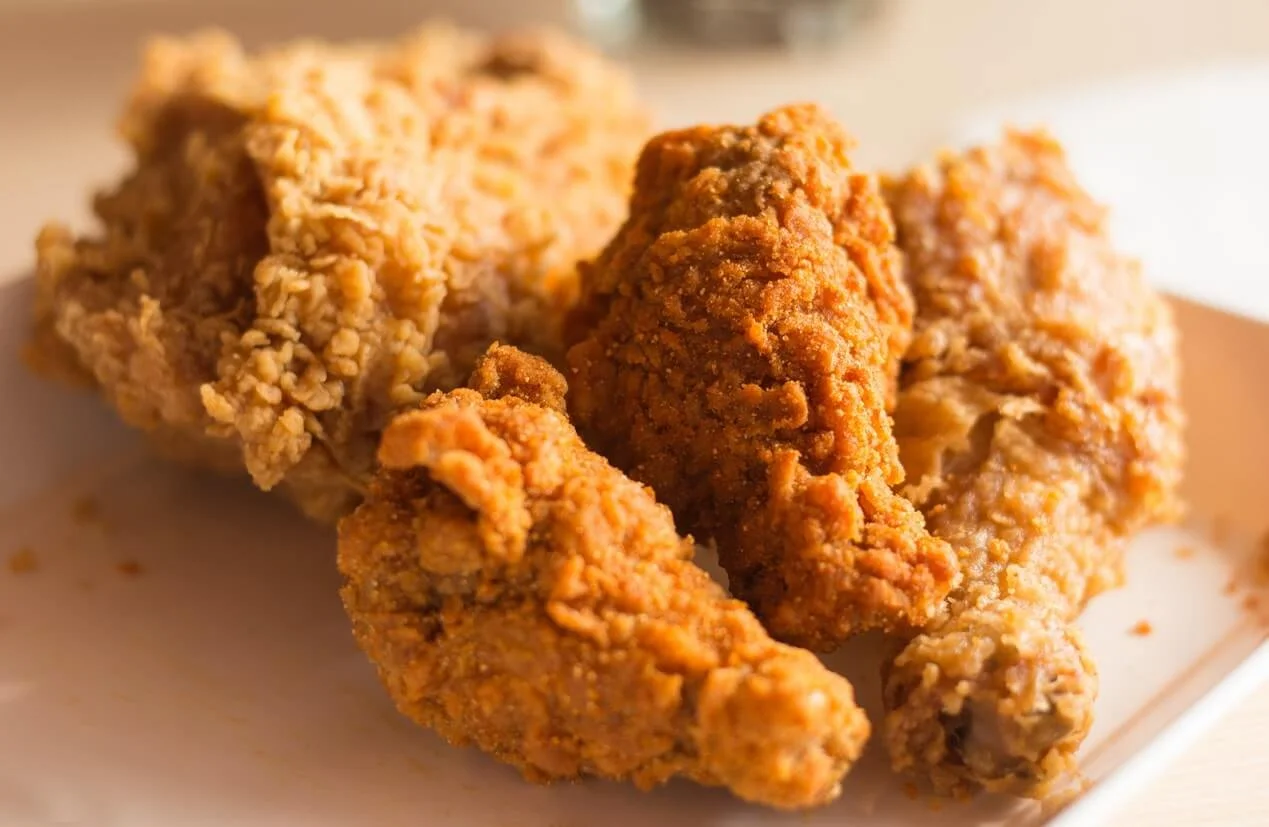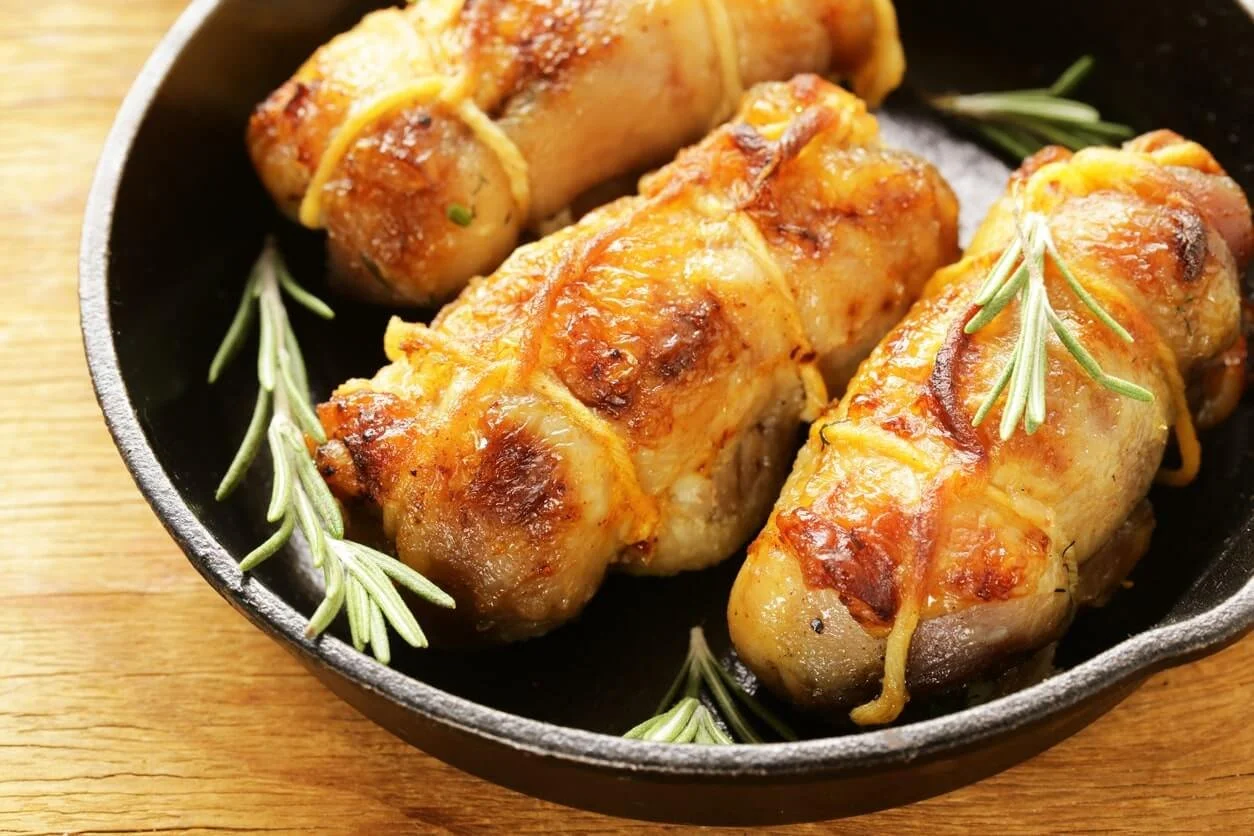4 Different Ways to Cook Chicken Legs
Discover > Texas Recipes > 4 Different Ways to Cook Chicken Legs
Chicken (how long does chicken last?) legs are a national favorite. They’re made up of the drumstick and thigh which are very often separated and cooked separately. The legs are made up of all dark meat which is characterized by its deeper flavor and of course, darker color. It’s darker because the meat contains more myoglobin.
Myoglobin is an iron and oxygen-binding protein. Because a chicken uses its legs most of the time, it requires more oxygen and therefore contains more myoglobin (the protein that carries the iron and oxygen over there). It causes the meat to have a more reddish pigment making it darker.
Chicken legs also taste better mostly because they have significantly more fat to render than the breast.
Different Ways to Prepare a Leg
Brine
Brining is the best way to season meat with salt and different herbs and spices. That being said you need to adjust your brine based on your cooking method. If you're making a roulade, you want the taste of the chicken and filling to stand out, so just brine it in some saltwater. If you’re grilling or baking the legs whole, however, you could use all those complex flavors to your advantage.
To make a brine follow these steps:
Consider the ingredients you’re going to use. Think of the type of salt you’re going to use. Flaky sea salt (how long does sea salt last?) dissolves nicely and tastes more natural than iodized table salt. Use around a tablespoon of salt for every cup of water you use. Exactly how much salt you use depends on a few things like what salt you use, how salty you like the chicken, etc. A good rule of thumb is 5% salt to water by weight.
Spices are important. Whole spices in particular. Peppercorns, mustard seeds (how long do mustard seeds last?), cloves, cardamom pods (how long do cardamom pods last?), coriander seeds (how long do coriander seeds last?), cumin seeds (how long do cumin seeds last?), the list goes on and on. To prep, the spices, drop them into a cold frying pan and place them over high heat. Toast the spices for 4-5 minutes, empty them onto a chopping board, lightly crush with the bottom of a saucepan, then transfer them to a bowl where you’ll make the brine.
Add the herbs to the bowl again here the skies the limit. Rosemary, parsley, cilantro, bay leaves, mint, lemongrass. Try some more exotic herbs like Thai basil, pineapple sage, asafoetida (how long does asafoetida last?), lavender, fennel (how long does fennel last?), etc. Simply add them to the bowl with salt and spices.
Acid is a complicated question and while you should feel free to use them, the brine should never be acidic. An easy taste test will let you know if it’s too acidic or not. Try citrus juice, wine, or vinegar as an acid.
Boil the appropriate amount of water and add it to the brine then whisk to dissolve the salt and help the herbs and spices infuse. Add some ice to the brine (not too much as to not dilute it) and completely cool the brine. Never brine in warm water because it’d be a breeding ground for bacteria. To avoid diluting the brine you can add a little ice to cool it a lot and if it’s still anything other than cold, add more ice then remove it using a spider or something else.
To brine the chicken, ideally, get a deep baking dish and evenly lay the chicken legs into the tray. Pour the brine over the chicken so that it's fully submerged then place it into the fridge overnight.
Avoid the crowds and shop for flaky sea salt, peppercorns, mustard seeds, cloves, cardamom pods, coriander seeds, cumin seeds, saucepan, mixing bowl, whisk, and baking dish online from the comfort of your home!
Season
Seasoning chicken with some flaky salt and cracked pepper is simple. There’s nothing wrong with simple and letting the chicken speak for itself, especially when you’re using dark meat.
Aside from flavor (brining is the best way to impart flavor deep into the meat), you might season the meat for color. Cayenne pepper or smoked paprika (how long does smoked paprika last?) gives a beautiful reddish color to the meat.
Make your life easier by ordering cayenne pepper or smoked paprika online; it's just a few clicks away!
Marinate
There’s a lot of debate about whether or not marinating actually works. If you ask me it’s a stupid debate to have because a) while it doesn’t do things like tenderizing meat necessarily it does flavor the meat (although again brining does a better job at this) and b) if you don’t believe in marinating just don't do it.
One way you can ‘marinate’ chicken is to brush it up with a BBQ or mop sauce before and during the cooking process.
Grill
Like pan-frying, directly grilling a whole leg of chicken is tricky because of its uneven shape. If you smoke or bake the chicken over the grill over indirect heat.
If you own a grill you’ll likely own a remote thermometer that you can insert into the chicken. It’s a relatively important little device because, unlike an oven, when you open a grill to test some meat, practically all the heat escapes.
Insert the thermometer into the thickest part of the chicken then place it onto the grill, not directly over a heat source. If you’re using wood and charcoal scrape them to one side of the bowl, and if you’re using a gas simply switch off one side of the burners.
Close the lid and heat the chamber up to 350°F. Control the temperature using the vents on the sides of the grill you have or the size of the flame if you’re using burners.
Keep an eye on the temperature, then when it reaches 165 take it off the grill and rest the meat for 10 minutes before serving.
I highly recommend purchasing a meat thermometer online for a convenient shopping experience!
Oven
If you don’t have the benefit of being able to use a grill, maybe you don’t own one, live in an apartment, or maybe it’s just raining. The oven is the best way to prepare an uneven cut like the leg.
Preheat the oven to 400°F. A hot oven is important whenever you roast anything with skin because those initial few minutes are the time to evaporate all the water out of the skin.
Place the brined, seasoned, or marinated chicken into a skillet or baking tray then place it on the top rack of the oven where it’s hottest. Bake for 10 minutes until the top looks dry and starts to brown.
If you’re smothering the chicken in BBQ sauce or mop sauce this would be a great time to brush on a second layer for more flavor.
Turn the oven down to 350°F, move the chicken to the lower part of the oven then bake the chicken for 10-15 minutes.
To check for doneness, insert a probe thermometer into the thickest part of the thigh making sure you avoid bone, look for a 165°F+ reading. Alternatively, make an incision on the inside of the joint and check for any blood and if the juices run clear.
After confirming the chicken is cooked through remove it from the oven, tent it in foil, then leave it to rest for 10 minutes.
Deep Fry
Fried chicken is the staple dish of the south. First made by West African slaves who wanted to make calorie-dense dishes out of the little supplies and ingredients they had available. A favorite in the south is buttermilk fried chicken, and you don’t have or can’t find buttermilk for some reason, make it by shaking a tablespoon of distilled vinegar in one cup of whole milk.
Place the separated chicken drumsticks and thighs into a bowl, pour over the buttermilk, and let it soak in the fridge for around 10 minutes while you prep the rest of the ingredients.
In a paper or plastic bag, combine plain flour (how long does flour last?), salt, pepper, garlic and onion powder (how long does onion powder last?), baking soda (how long does baking soda last?), cayenne pepper, and smoked paprika and set it aside.
You can also shallow fry the chicken but it’s easier to deep fry it in a high smoke point oil like peanut oil, canola oil, sunflower oil, and vegetable oil (how long does vegetable oil last?). One of the most delicious fats you can fry chicken in is lard. It has a smoke point of around 375°F which makes it perfect for frying.
If you don’t have a deep fryer, drop a couple of blocks of lard into a thick-bottomed stainless steel pot or saucepan. Melt it down and bring it up to 350°F. While you’re at it you can also preheat your oven to 200°F so you can keep the chicken warm and finish cooking it should you accidentally take it out slightly too early.
Take the chicken out of the fridge, and drop the pieces into the bag with the seasoned flour. Give the bag a shake to evenly coat the chicken.
Drop a few pieces of chicken into the hot oil. How much depends on the size of the pot. A smaller pot will cook the chicken faster and more efficiently. A large saucepan had a diameter of around 8 inches which is fine for 3-4 legs or thighs depending on the size of said cuts. It’s always better to avoid overcrowding the pan.
Fry the chicken for 10-12 minutes, remove it from the fat, drain it on a paper towel, then place it into the oven while you finish the rest of the chicken.
If you're looking for flour, garlic, onion powder, peanut oil, canola oil, sunflower oil, or vegetable oil, buying it online is your best bet!
Roulade
Removing the bone from a whole chicken leg takes some practice to do perfectly, but don’t let that stop you because it’s by no means difficult. One rule to remember is to always cut as close to the bone as possible.
Start by cutting around the base of the drumstick. Fully separate the skin and little meat from the top and base of the bone before moving onto the next step.
Lay the leg onto a cutting board with the bottom facing upwards. Take a small, sharp knife and cut to the bone, all the way from the top of the thigh joint to the bottom of the drumstick.
Making quick, short cuts, cut down the bones and around them. Once most of the meat is separated you can either pull the bone out or cut the last little pieces. Trim any tendons or cartilage that is left on the thigh before moving on to the next steps.
The next steps are thoroughly up to you. You can wrap almost anything in chicken. One of my favorite things to do is to wrap strips of mozzarella, fresh basil leaves, and julienned chilies in the chicken, then wrap the chicken in parma ham or bacon. Insert toothpicks into the seams of the ham and chicken to keep it in place.
Preheat the oven to 350°F and place an ovenproof skillet over high heat. Add some garlic oil (or regular oil) into the hot skillet and sear the meat on all sides then just place the pan into the preheated oven.
Bake the roulade for 10-15 minutes or until an inserted thermometer reads 165°F. Turn the roll halfway through to avoid burning the side in contact with the hot pan.







